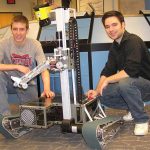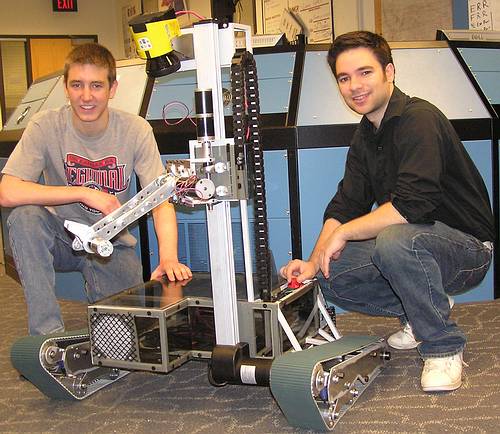 Contacts:
Contacts:
Andy Frick, Iowa State MAVRIC team leader, 563 650-8750, gerandy@iastate.edu
Matthew Nelson, Space Systems and Controls Lab, 515 294-2640, mnelson@iastate.edu
Mary Jo Glanville, Engineering Communications and Marketing, 515 294-8787, mglanvil@iastate.edu
Ames, Iowa—Building a Mars rover is, to say the least, a challenging task. The Mars terrain, after all, is unforgiving—dusty and hilly and with many obstacles blocking the path.
A team of Iowa State students, however, has come up with an innovative approach for handling that rough Martian terrain. And they will find out just how well their approach works when they compete in the 2009 Mars Society University Rover Challenge (URC) May 28–30. The competition, which is held at the Mars Desert Research Station in Utah, requires the teams to carry out four complex missions in a Mars-like environment.
“We have a special hybrid design for the vehicle’s tracks,” says Andy Frick, senior in aerospace engineering (AerE) and MAVRIC (Mars analog vehicle for robotic inspection and construction) team leader. “They are a crossover between what NASA calls a ‘rocker bogie,’ which is basically the six-wheel design that is on the Mars rovers Spirit and Opportunity and is very nice for climbing obstacles but not very good for speed, and a track drive based on a flexible belt. We looked at some commercially available tracks, but they were too heavy so we decided to design our own.”
Two mechanical engineering students—Derek Joseph and Trevor Heithoff—designed the unique track. “We looked at various other things such as snowmobile tracks and ATV equipment to get ideas and then tried to make something as lightweight as possible,” says Joseph, who has just completed his freshman year at Iowa State.
This is the second time that Iowa State students have entered the URC, but at four times the size, this year’s entry bears little resemblance to the 2008 entry.
Time to carefully design and test the rover is a luxury the MAVRIC team did not have a year ago. “Last year, we got into it late and tried to adapt another vehicle to meet the criteria,” explains Frick. “Dust got into everything and then our power supply failed, causing the internal computer to fry. We were still able to compete, but the rover had to drive with a laptop strapped to the top.”
The students have used last year’s experience to improve this year’s model. “It’s the things that go wrong that teach you the most about how to improve the next project,” says Jerry Stoner, AerE graduate student and guidance, navigation, and control specialist.
To combat the dust issue, the team has encased the equipment in boxes and is filtering the airflow. With two semesters to complete the project, they allowed ample time for testing the vehicle to ensure that everything works together as it should. “Our goal was to test and improve and not just troubleshoot,” adds Stoner.
The rover is equipped to carry out four separate challenges. The first requires the teams to demonstrate autonomous navigation. The rover must find an astronaut and deliver an oxygen container to him. The second is a construction task. A robotic arm is mounted on top of the vehicle, and it will be used to reach bolts on an equipment panel and tighten them.
The third challenge is an extremophile (organism that lives in extreme environments) search task. “It’s an astrobiology mission because scientists suspect Mars might have harbored bacteria in the past, so we have to search to find them in the soil,” Frick explains. “One of our team members—Royce Woodroffe—is a double major in AerE and microbiology, so he is our astrobiologist and is helping us identify what sensors to use.”
The fourth challenge is a surveying task that requires identification of targets at a distance and then finding the exact bearings to locate the targets.
Nine teams are competing in the URC. In addition to Iowa State, the field includes Brigham Young University; Georgia Institute of Technology; Oregon State University; University of California, Los Angeles; University of Nevada, Reno; University of Waterloo (Canada); Warsaw University of Technology (Poland); and York University (Canada).
Team MAVRIC is supported by the Space Systems and Controls Lab (SSCL), the Iowa Space Grant Consortium, and the Aerospace Robotics Lab (ARL). Matthew Nelson, SSCL chief design and operations engineer, and Soon-Jo Chung, AerE assistant professor and director of the ARL, are the team advisors.
The 2009 MAVRIC team members are
Insu Chang, graduate student, aerospace engineering, Seoul, South Korea
Andy Frick, senior, aerospace engineering, Bettendorf
Keegan Gartner, graduate student, mechanical engineering, Hastings, Minnesota
Trevor Heithoff, senior, mechanical engineering, Ames
Derek Joseph, sophomore, mechanical engineering, Lenexa, Kansas
Matthew Kruse, junior, mathematics, Lansing
Christopher Reis, sophomore, electrical engineering, Storm Lake
Jerry Stoner, graduate student, aerospace engineering, Johnston
Royce Woodroffe, senior, aerospace engineering and microbiology, Fort Madison
